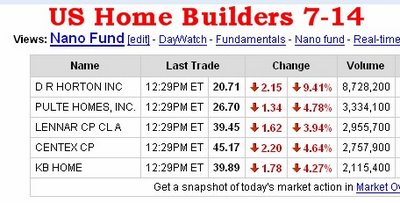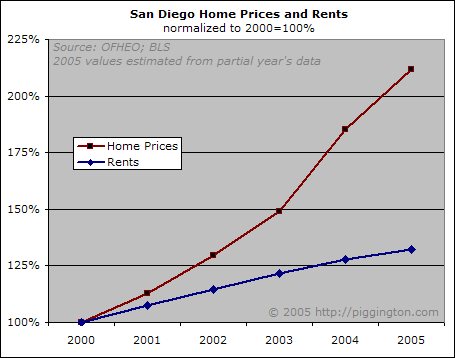
The ETF Retail Holders has been riding up an ascending trendline for months. But last May the retail index suddenly plunged through its rising trendline. And last week, Retail Holders suffered a huge drop. July isn't over yet, but we see enough to know that retail is in trouble. And consumer spending, as you may remember, constitutes about 70% of the Gross Domestic Product of the nation. When consumers cut back, the US economy is in trouble. Strange that nobody seems to be noticing what's happening in retail.
What's the biggest purchase by American families? It's a home or in many cases a second home. Well, not only is retail in trouble, housing is in trouble. The Housing ETF has violated a trendline is in a waterfall collapse. So much for housing, it's kaput, finished. How's the US consumer going to pull money out of his "housing ATM" this year?
The consumer Discretionary Spending ETF tracks items that consumers don't absolutely need for living purposes. In other words, items that consumers can live without. Stocks in this group include Disney, Home Depot, Target, McDonalds, GM, Viacom. Suddenly last week, Consumer Discretionary got in line with the other consumer charts, and Consumer Discretionary fell apart. It's increasingly apparent that the US consumer has put a lock on his wallet while women are in the process of zipping up their hand bags. This will all become apparent within a matter of a few month or so.
Whole Foods is a stock that I've watched with interest. The company has been growing rapidly, and it has been the envy of every supermarket chain. The only catch with this company is that its prices are high -- thus the nickname, "Whole Paycheck." The stores are great, the selection is fabulous, but again those prices. I've wondered whether whole families can do their shopping at Whole Foods. To my mind, this a "good time" chain of stores, specializing in "health-type foods." But with the growth of organic foods, the big chains are now getting into the act. Even our local Safeway now has an organic counter. Can a chain with high prices compete with the highly-competitive grocery super-chains? Guess we'll find out.
Whole Foods hit a high close of 79.90 on December 28, 2005. Friday it closed at 58.39, down 26%. Customers of Whole Foods may be running out of "luxury money" -- or else competition is hitting the chain. Or both. Interestingly, Whole Foods has made the cover of magazines over the last few months. But Whole Foods shouldn't feel bad -- even Wal-Mart has been hitting the skids. Wal-Mart, trading as high as 70.25, closed Friday at 43.05, down 38.5% from its high.
America's consumers have been on a tear. Looking at the charts and stock prices say it's over.



















